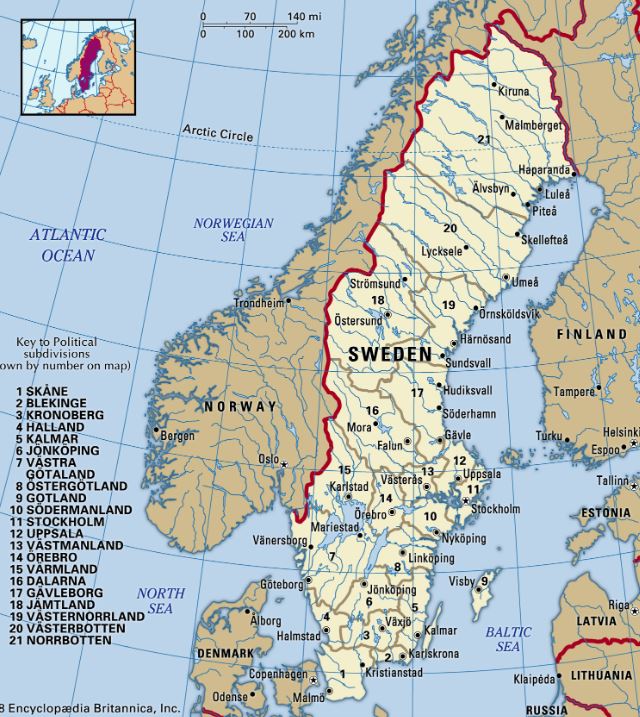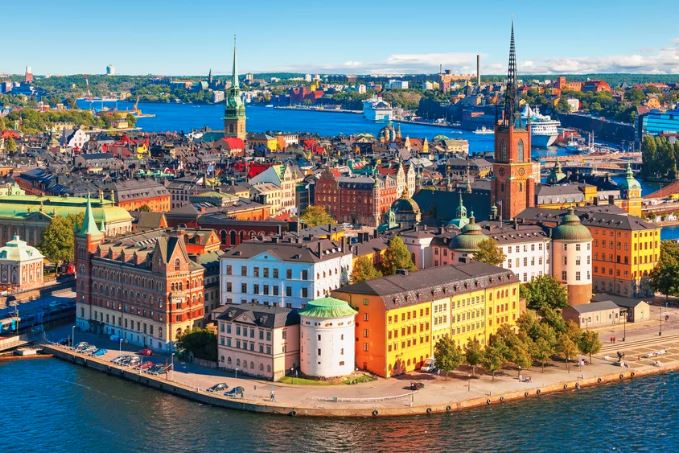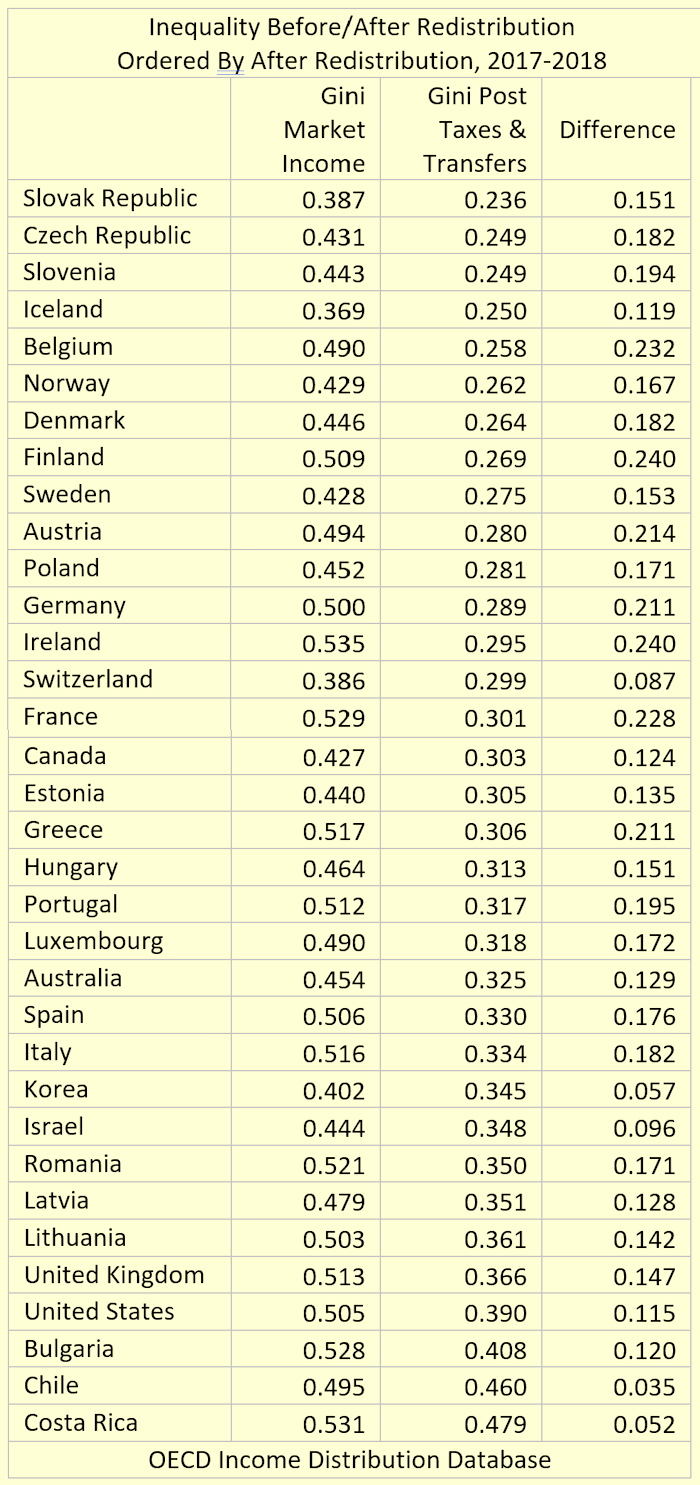|
Sweden: Whither the Welfare State?

I.
The Environment
A. Geography
- Relatively isolated; allowed Swedes to avoid major war since
1813. Rich endowment of timber, and iron ore and other
natural resources.
B. Sociological
- Small population - 10.5 million, much smaller than Texas
(30m), but larger than Denmark (5.9m), Norway (5.5m), or
Finland (5.5m). Historically, geographic isolation contributed
to cultural homogeneity - in 1900 only 1% of the population
was foreign born. Welfare programs did not seem to distribute
income from one group to another, supporting the growth of the
welfare state. The foreign-born share grew to 14% in 2010 and
20% today, sparking a populist backlash.
C.  Political
- Dominant since 1932, the Social Democratic Party lost
control during 1936, 1976-1982, 1991-1995, 2006-2014, and
currently since October 2022 when Ulf Kristersson from the
Moderate party formed a coalition of right-leaning parties
with the Sweden Democrats, Christian Democrats, and Liberals
that gained power after a general election. The Sweden
Democrats, now the largest of the coalition parties in the
Riksdag parliament (although the Social Democrats are still
the largest single party overall) is an anti-immigrant ("Keep
Sweden Swedish") right-wing populist party, and the policies
of the current government largely reflect its values. Political
- Dominant since 1932, the Social Democratic Party lost
control during 1936, 1976-1982, 1991-1995, 2006-2014, and
currently since October 2022 when Ulf Kristersson from the
Moderate party formed a coalition of right-leaning parties
with the Sweden Democrats, Christian Democrats, and Liberals
that gained power after a general election. The Sweden
Democrats, now the largest of the coalition parties in the
Riksdag parliament (although the Social Democrats are still
the largest single party overall) is an anti-immigrant ("Keep
Sweden Swedish") right-wing populist party, and the policies
of the current government largely reflect its values.
II.
Industrial Organization
A. Nationalization
- SDP philosophy did not call for the nationalization of
industry. Some were nationalized to prevent them from
facing bankruptcy, but some of those have been returned to
private hands.
B. Monopolies
and Industrial Concentration - Small domestic market
contributes to high industrial concentration ratios.
Dominance of small number of large multinational
companies. Still, a high level of foreign competition
and extensive system of consumer cooperatives.

III. The Labor Market and Labor Relations
A. Collective
Bargaining -
1.
Basic Agreement - Swedish Confederation of Trade Unions
(LO) formed in 1898, and Swedish Employers Association (SAF)
formed in 1902. In 1938, employers and labor accepted
the Basic Agreement of Saltsjobaden, under which management
recognized the labor unions and established general rules
about layoffs and dismissals. Both sides agreed to hold
direct negotiations before resorting to strikes or lockouts.
2.
Centralized bargaining - Developed after World War
II. Employers wanted more orderly bargaining.
Unions wanted wage solidarity (largest wage increases
to the lowest-paid workers). Wage negotiations take
place at the national level and result in a binding
framework. Local negotiations are held between
employers' groups and union affiliates.
3.
Evaluation - 1945-1970, central bargaining worked
well. In 1970 departures from the central agreement
became common and inflation rose above the average of other
industrial countries. Disagreements over wage solidarity
have weakened the system, leading to independent action by
machine workers (who had been sacrificing larger pay raises),
and centralized bargaining was replaced by standard
industry-level bargaining in 1983..
B. Active
Labor Market Policy - Includes programs to increase the
demand for labor, training programs to tailor labor supply to
new job openings, and to match supply and demand through job
information and placement services. National and 24
regional Labor Market Boards. Unemployment benefits are
less generous in Sweden than OECD average.
In 2017, as % of GDP, expenditures on active programs
were 0.1% in the U.S., 0.52% as an OECD average, 0.65% in
Germany, 0.87% in France, 1.25% in Sweden, and 1.96% in
Denmark. On the other hand, expenditures on passive programs
(unemployment compensation) were 0.14% of GDP in the U.S.,
0.53% in Sweden, and 0.68% as an OECD average. (Source: OECD
Employment Outlook 2020).
C. Codetermination
and Employee Ownership - Workers participate in
management through works councils and representation on boards
of directors.
IV.
The Governmental Sector
A. Fiscal
and Monetary Policy - Even before the Depression,
policies designed to reduce unemployment were proposed in
Sweden.
1.
Investment reserve funds - allowed the government to
control rough one eighth of private investment by awarding tax
credits to companies that save during boom periods and invest
during downturns. According to Taylor, successfully
stabilized investment. Abolished in 1991.
2.
Monetary policy - the Riksbank once exercised direct
control over bank lending. In recent years, focus on inflation
reduction.
B. Social
Welfare and Income Redistribution - Although it no
longer has the highest level of spending in the world, Sweden
has an extensive welfare state that includes (excerpted
from here):
§ Family Care: Day-care and preschool
programs are almost free, with fees based on family income: If
parents are unemployed, child care is totally free. Swedish
pregnant women get free and subsidized prenatal care and
parents get 480 days of paid leave when a child is born or
adopted, which they can share (240 days each). (Sweden was the
first country to offer fathers paid parental leave, in 1974.)
Parents get about 80 percent of their salaries when they stay
home with a sick child (up to age 12). They can take this
temporary leave up to 120 days a year.
§ Education: Kindergarten through high
school is free, as are school lunches. Undergraduate
college/university tuition is also free. If students need
money for books, food, and housing, they get nearly
no-interest loans. Swedish undergraduates aged 16–20 also get
$136 monthly stipends during the school year. If their
families are low-income, they may get more.
On the efficiency side, Sweden has an extensive school-choice
system.
§ Medical Care: Medical and hospital care
are basically free until age 20. After then, doctor visits
cost Swedes $10 to $32, or up to $38 for specialists. After
people meet a $119 annual deductible, all care is free.
Moreover, medicine is free after a $239 yearly deductible.
Drugs are the same price at all pharmacies, so people needn’t
shop around for the best price.
§ Unemployment Benefits: Provided from the
government and from union insurance plans. The plans provide
80 percent of Swedes’ wages/salaries for the first 200 days
they’re out of work and 70 percent for the next 100.
§ Pensions: Pensions are covered by the
government or union/employer plans. If Swedes have low-paying
jobs (under $40,000 a year), the government and employers pay
into the plans, but the employees don’t contribute. If they
have middle- and higher-income jobs, they must contribute,
along with their employers.
§ Transportation Perks: Government subsidies
vary. For example, people pushing baby strollers or carriages
in some cities (such as Stockholm) ride for free on the buses.
In others (such as Gothenburg), retired Swedes pay nothing,
except during rush hours.
§ Housing Subsidies: Local governments
subsidize low-income and elderly Swedes’ rental housing and
also help them find it. The amount is based on their income
and the local cost of living. In large cities like Stockholm,
affordable housing is hard to find—whether to buy or rent (for
which the wait is long). Thus Swedes now live farther outside
the central cities and tend to buy their houses/apartments.
§ Wages: Sweden doesn’t have a minimum wage.
Instead, strong unions and employers negotiate wages/salaries.
This is particularly important for low-income workers: A
cashier at a Swedish McDonald’s was already earning $15 an
hour a few years ago.
§ Taxes: Swedes pay income tax to both
national and local governments. In fact, in 2017 Sweden had
the highest top marginal tax rate among OECD countries,
followed by Denmark, Japan, Greece, France, and Canada. In all
these countries, the top rate is over 50 percent. While some
Swedes grumble about their taxes, a 2017 OECD public opinion
poll (based on Gallup/World Bank data) found that 50 percent
trusted their government, while the figure was only 30 percent
for Americans.
Critics maintain that the high tax rates have damaged
incentives. The average Swedish work week is one of the
shortest in the world. High taxes have driven a
significant part of income and production underground in the
form of do-it-yourself home improvements and barter
activities.
Henrik Jacobsen Kleven addresses the question, "How
Can Scandinavians Tax So Much?" and finds (1) that tax
compliance rates are high in those countries, partly because
of 3rd-party reporting; (2) low levels of legal tax avoidance
due to a broad tax base that offers limited scope for reducing
tax liability through deductions and income shifting; and (3)
a fiscal system that spends relatively large amounts on
means-tested transfer programs that could reduce work
incentives, but also spends relatively large amounts on the
public provision and subsidization of goods that are
complementary to working, including child care, elderly care,
and transportation. "Such policies represent subsidies to the
costs of market work, which encourage labor supply and make
taxes less distortionary."

C. Covid-19
Response - Aside from closing its external
borders, Sweden was slow to take action against Covid-19. It's
the only country in Europe that never had a serious lockdown,
and relatively few people ever wore masks. The chief
epidemiologist was hoping to reach herd immunity quickly
without too many deaths, but the King declared it a failure.
Sweden has had fewer excess deaths than many other European
countries, but higher death rates than its neighbors.
|